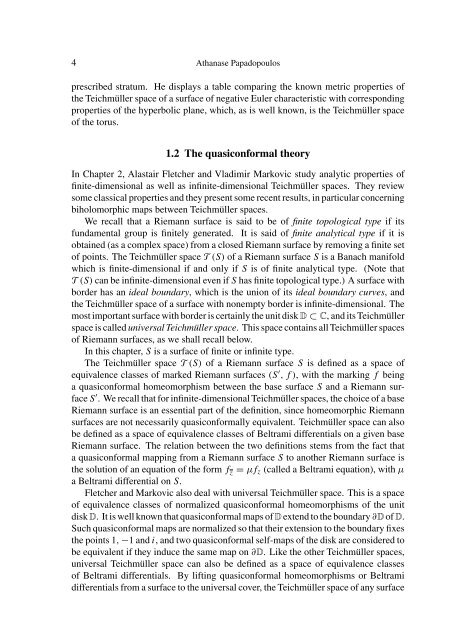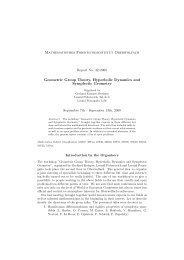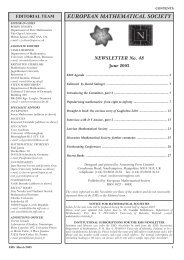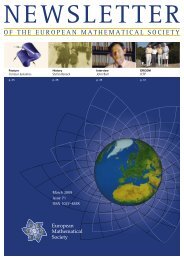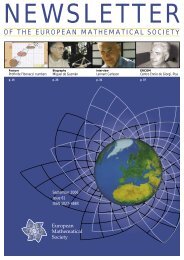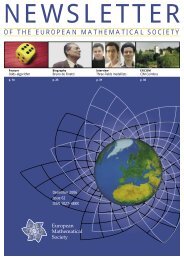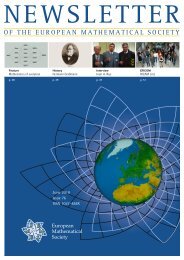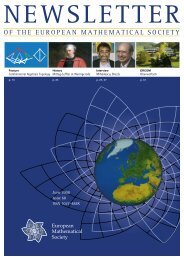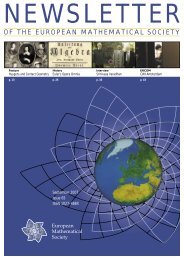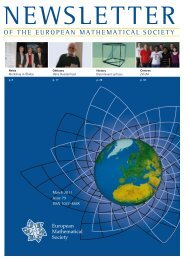Introduction to Teichmüller theory, old and new, II
Introduction to Teichmüller theory, old and new, II
Introduction to Teichmüller theory, old and new, II
You also want an ePaper? Increase the reach of your titles
YUMPU automatically turns print PDFs into web optimized ePapers that Google loves.
4 Athanase Papadopoulos<br />
prescribed stratum. He displays a table comparing the known metric properties of<br />
the <strong>Teichmüller</strong> space of a surface of negative Euler characteristic with corresponding<br />
properties of the hyperbolic plane, which, as is well known, is the <strong>Teichmüller</strong> space<br />
of the <strong>to</strong>rus.<br />
1.2 The quasiconformal <strong>theory</strong><br />
In Chapter 2, Alastair Fletcher <strong>and</strong> Vladimir Markovic study analytic properties of<br />
finite-dimensional as well as infinite-dimensional <strong>Teichmüller</strong> spaces. They review<br />
some classical properties <strong>and</strong> they present some recent results, in particular concerning<br />
biholomorphic maps between <strong>Teichmüller</strong> spaces.<br />
We recall that a Riemann surface is said <strong>to</strong> be of finite <strong>to</strong>pological type if its<br />
fundamental group is finitely generated. It is said of finite analytical type if it is<br />
obtained (as a complex space) from a closed Riemann surface by removing a finite set<br />
of points. The <strong>Teichmüller</strong> space T (S) of a Riemann surface S is a Banach manif<strong>old</strong><br />
which is finite-dimensional if <strong>and</strong> only if S is of finite analytical type. (Note that<br />
T (S) can be infinite-dimensional even if S has finite <strong>to</strong>pological type.) A surface with<br />
border has an ideal boundary, which is the union of its ideal boundary curves, <strong>and</strong><br />
the <strong>Teichmüller</strong> space of a surface with nonempty border is infinite-dimensional. The<br />
most important surface with border is certainly the unit disk D ⊂ C, <strong>and</strong> its <strong>Teichmüller</strong><br />
space is called universal <strong>Teichmüller</strong> space. This space contains all <strong>Teichmüller</strong> spaces<br />
of Riemann surfaces, as we shall recall below.<br />
In this chapter, S is a surface of finite or infinite type.<br />
The <strong>Teichmüller</strong> space T (S) of a Riemann surface S is defined as a space of<br />
equivalence classes of marked Riemann surfaces (S ′ ,f), with the marking f being<br />
a quasiconformal homeomorphism between the base surface S <strong>and</strong> a Riemann surface<br />
S ′ . We recall that for infinite-dimensional <strong>Teichmüller</strong> spaces, the choice of a base<br />
Riemann surface is an essential part of the definition, since homeomorphic Riemann<br />
surfaces are not necessarily quasiconformally equivalent. <strong>Teichmüller</strong> space can also<br />
be defined as a space of equivalence classes of Beltrami differentials on a given base<br />
Riemann surface. The relation between the two definitions stems from the fact that<br />
a quasiconformal mapping from a Riemann surface S <strong>to</strong> another Riemann surface is<br />
the solution of an equation of the form f z = μfz (called a Beltrami equation), with μ<br />
a Beltrami differential on S.<br />
Fletcher <strong>and</strong> Markovic also deal with universal <strong>Teichmüller</strong> space. This is a space<br />
of equivalence classes of normalized quasiconformal homeomorphisms of the unit<br />
disk D. It is well known that quasiconformal maps of D extend <strong>to</strong> the boundary ∂D of D.<br />
Such quasiconformal maps are normalized so that their extension <strong>to</strong> the boundary fixes<br />
the points 1, −1 <strong>and</strong> i, <strong>and</strong> two quasiconformal self-maps of the disk are considered <strong>to</strong><br />
be equivalent if they induce the same map on ∂D. Like the other <strong>Teichmüller</strong> spaces,<br />
universal <strong>Teichmüller</strong> space can also be defined as a space of equivalence classes<br />
of Beltrami differentials. By lifting quasiconformal homeomorphisms or Beltrami<br />
differentials from a surface <strong>to</strong> the universal cover, the <strong>Teichmüller</strong> space of any surface


